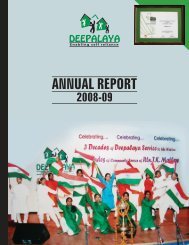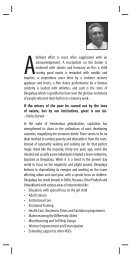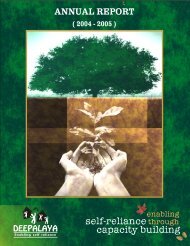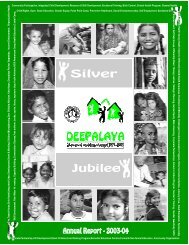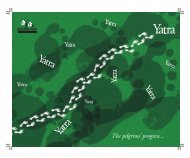Report 2011 - Deepalaya
Report 2011 - Deepalaya
Report 2011 - Deepalaya
Create successful ePaper yourself
Turn your PDF publications into a flip-book with our unique Google optimized e-Paper software.
AND THE ACCESSIBILITY OF THE CLINIC IN GUSBETHI<br />
MANAGEMENT OF MEDICAL WASTES<br />
According to the ONU, the medical wastes are considered as the most dangerous wastes after the radioactive<br />
wastes. About 15 to 25% of them are contaminated and represent high risks for health. All around the world,<br />
use of medical stuffs is increasing but there is no more way to eliminate them. Nevertheless, we have been<br />
noticed that in Gusbethi clinic, used needles are thrown in the same waste bin as others medicals and nonmedicals<br />
wastes. The risk of infection is thus increased, because anybody can hurt himself with these needles<br />
especially the sweeper while cleaning the clinic and even some patients. Our recommendation would be to use<br />
special containers (e.g. BioHazard boxes) that cannot be opened by anyone for used needles and these wastes<br />
should then be destroyed in the right way.<br />
In the clinic, we have seen a machine that can grind and cut the needles after use, but it is not used by staff<br />
people because it is not always working. This is also a good option but needles box is more affordable and more<br />
secure to people in the clinic.<br />
HUMAN RESSOURCES AND ACCESSIBILITY OF THE CLINIC<br />
For sure a recommendation to improve the efficiency of the clinic would be to get more staff but we know that<br />
because the clinic is located in a small village it is usually difficult to achieve.<br />
We think that improving the access to the clinic would be very beneficial. With these roads conditions, the lack<br />
of electricity and the difficulties to villagers to get transportation up to the clinic, this is sometimes difficult to<br />
reach it. Transport service provided by <strong>Deepalaya</strong> from and to the clinic is an excellent way to overcome this<br />
problem and should be continued.<br />
In the clinic we have also noticed that all X-Rays equipments are available and we think that partnership could<br />
be made with another Hospital, e.g. Tauru Hospital, to operate X-Rays in Gusbethi without hiring a radiologist.<br />
With the help of a technician who would come periodically to the clinic, X-Rays could be operated and then<br />
sent to Tauru Hospital to be read by the doctor.<br />
Conclusion<br />
From what we’ve learned of this research project, we can now say that in the area deserved by <strong>Deepalaya</strong>'s<br />
health services in Gusbethi, a lot of factors contribute to the high rate of anemia in the area, as seen in overall<br />
India. Malnutrition, lack of iron in diet intake, blood losses and infections such as malaria, hookworms and<br />
parasites are responsible for a big part of the problem. The water access, lack of hygiene, family planning,<br />
education, non-utilization of footwear and open air defecation contribute to anemia. By preventive measures,<br />
outcomes on pregnancy such as low birth weight of the baby, maternal mortality, abortions and new-born<br />
mortality, postpartum hemorrhage and sepsis can be reduced. Otherwise, <strong>Deepalaya</strong>’s organization could<br />
improve the situation in Mewat’s district by improving the knowledge of the population about anemia; what is<br />
it How to prevent it and to reduce it Creating more awareness on anemia in the villages and give advices to<br />
the people about nutrition, hygiene, treatment of the water and family planning methods must constitute a<br />
good way to achieve this goal. Promotion of iron and calcium supplementation, regular antenatal care visits and<br />
hospital deliveries is also essential. With time and knowledge, everything is possible.



